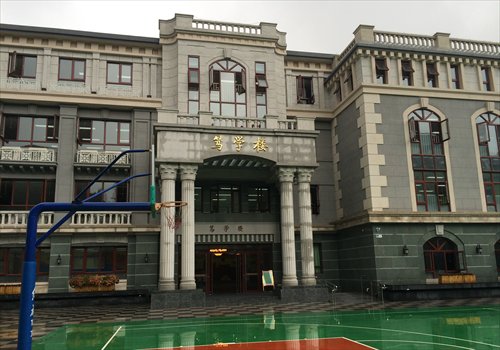

The classroom building that has been erected at where the former Dengshikou Congregational Church stood. Photo: Li Ying/GT
In an 1984 essay published in Harvest, a literary bimonthly, Xie recounted her four years spent at Bridgeman Girl's School (1914-1918) with a mixture of veneration and vexation, but ultimately, gratitude.
"Most of my schoolmates were Protestants," Xie wrote. "Permanently adorned in [the school's uniform of] a blue blouse matched with a green skirt, their expressions too, seemed to be fixed: they were always severe, rigid and humorless."
On Sundays, all students were required to attend mass, as well as go to "Sunday School," which consisted of listening to stories from the bible.
"Mass and bible time was a bother. I sometimes skipped Sunday School, because it was the only time during the week I could otherwise spend with my parents and siblings. It was also the only time that I could help my mother with the household chores," wrote Xie.
However, Xie concludes the essay on a note of affirmation for her religious education.
"The solemnity of the education I received tempered my natural unruliness, and gave me a stable foundation for the color that was awaiting me in university life."
Ideological struggle
It was not long however, before China's missionary schools again came under ideological scrutiny. This time, the pressure came from China's intellectual classes, who, under the banner of the New Culture Movement, were persistent in their critique that if China wanted to survive, it would have to go through the same process of modernization as the Western states did.
Central to the project of modernization was legitimizing science as the foundation of society. Because certain scientific precepts were seen as antithetical to the Christian church's teachings, the missionary schools, which had in fact played a large role in disseminating Western theories of science in China, were again the target of public resentment.
"If traditional culture was the main ideological obstacle that prevented Christianity from becoming widespread in China during the late Qing period, the New Culture Movement, promoting ideas of democracy and science…made the dissemination of Christian teachings even more difficult," wrote Ji Hong, a research fellow with the Institute of American Studies of Chinese Academy of Social Sciences, in an essay titled "Studies on American Protestant Missionary Middle-Schools in Beijing between 1920-1941."
"[The missionary schools] were criticized by progressive intellectuals," wrote Ji.
By 1950, with the realization of the modern Chinese state under the Communist Party of China, the missionary schools faced another twist of their fate, with any that remained being converted into public schools run under the administration of central and provincial State apparatus. The schools were widely condemned as a painful reminder of China's humiliating earlier defeats, and symbols of Western imperialism.
The persecution of the former missionary schools however, was not over. During the ideological struggle of the Cultural Revolution (1966-76), despite their official status as public schools like any other, both students and faculty at the former missionary schools suffered.
Students and staff at the school were seen as more likely to have come from privileged or bourgeois backgrounds.
"I witnessed some really sad things during the Cultural Revolution," said Liu Chuanzhi, a student of Beijing No.25 Middle School at the time, in comments made to Caijing magazine in October 2012.
Liu later founded China-based PC maker Lenovo Group.
An enduring legacy
The Dengshikou Congregational Church was demolished once and for all in 1978.
In Beijing, few of the original buildings from any of the missionary school campuses remain. And yet, in present-day China's more open, inclusive social and political climate, these lost missionary schools are being remembered with increasing fondness.
"A century ago, Yu Ying had already adopted an approach to education that encouraged students to pursue their hobbies and interests outside of class, which today is still considered progressive," said Qi. The school's clubs at the time, he added, included music and dancing, literature and photography, football, tennis and even ice hockey.
The school's attitude toward extra-curricular activities was summed up thus by Ernest T. Shaw, one of Yu Ying's early headmasters, in their 1931 Year Book: "No curriculum or organization, no matter how carefully put together, can provide for every student's needs. These clubs furnish the best possible setting for students to acquire the habit of coordinating their desires and the demands of life when the need arises for doing things together."
Efforts are also being made by scholars to restore the forgotten history of Beijing's missionary schools.
"It was a pity that the church was destroyed," said Liu Yang, an expert on Beijing's regional architecture. Liu is currently writing a book on the capital's religious buildings, and has been collecting stories about Beijing's lost missionary schools.
"These stories should be kept and passed on," he said.
Copyright ©1999-2018
Chinanews.com. All rights reserved.
Reproduction in whole or in part without permission is prohibited.